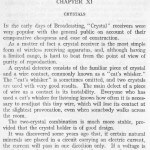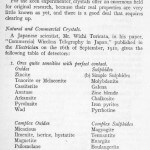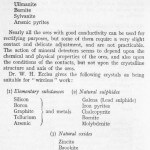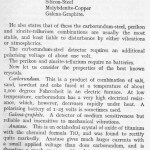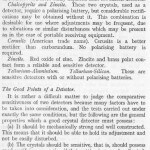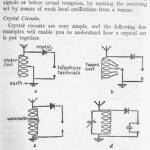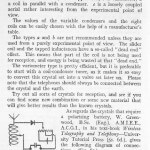In the early days of Broadcasting, “Crystal” receivers were very popular with the general public on account of their comparative cheapness and ease of construction.
As a matter of fact a crystal receiver is the most simple form of wireless receiving apparatus and, although having a limited range, is hard to beat from the point of view of purity of reproduction.
A crystal detector consists of the familiar piece of crystal and a wire contact, commonly known as a “cat’s whisker”. The “cat’s whisker” is sometimes omitted, and two crystals are used with very good results. The main defect of a piece of wire as a contact is its instability. Everyone who has used a cat’s whisker for listening knows how often it is necessary to readjust this tiny wire, which will lose its contact at the slightest provocation, even when somebody walks across the room.
The two crystal combination is much more stable, provided that the crystal holder is of good design.
It was discovered some years ago that, if certain natural minerals are placed in a circuit carrying n electric current, the current will pass in one direction only. If a voltage is applied in such a way as to make the current flow in the reverse direction, the mineral or the “crystal” will offer such a resistance that the resultant current will be negligible.
The property of allowing an electrical current to flow in one direction only is known as rectification, and the crystal therefore is referred to as a “rectifier” or detector (of “wireless” signals).
There exists a great diversity of opinion as to the nature of the rectifying property of crystals, but this lack of definite knowledge does not preclude us form using crystals for the purpose of “wireless” reception.
Some of the crystals are, so to say, born rectifiers, and will rectify on their own without any additional batteries, but others will do their work best if they have a small polarizing battery in series.
For the keen experimenter, crystals offer an enormous field for original research, because their real properties are very little known as yet, and there is a good deal that requires clearing up.
Natural and Commercial Crystals
A Japanese scientist, Mr. Wichi Toricata, in his paper “Commercial Wireless Telegraphy in Japan”, published in the Electrician on the 16th of September 1910, gives the following table of detectors:
- I. Ores quite sensitive with perfect contact
Oxides Sulphides
Zincite (b)Simple Sulphides
Tenorite or Melaconite Molybdenite
Cassiterite Galena
Anatase Zinc blende
Arkansite Chalkosite
Pyrolusite Iron pyrites
Wad Pyrrhotine
Complex Oxides Complex Sulphides
Micacious Magyagite
Ilmenite, iserine, hystatite Tennantite
Magnetite Enargite
Psilomelane Schwatzite
(c) Metallic combinations
Lolingite
Meteorite
Smaltite
- II. Ores sensitive with light contact
(a) Sulphides (b) Metallic combinations
Simple sulphides Niccolite
Marcasite or kyrosite Domeykite
Covelline Strutterudite
Iridosmine
Complex sulphides
Siegenite
Copper pyrites
Cobaltine
Ullmanite
Bornite
Sylvanite
Arsenic pyrites
Graphite
Arsenic
Nearly all the ores with good conductivity can be used for rectifying purposes, but some of them require a very slight contact and delicate adjustment, and are not practicable. The action of mineral detectors seems to depend upon the chemical and physical properties of the ores, and also upon the conditions of the contacts, but not upon the crystalline structure and axis of the ores.
Dr. W. H. Eccles gives the following crystals as being suitable for “wireless” work:
- I. Elementary substances
Silicon
Boron
Graphite and metals
Tellurium
Arsenic
- II. Natural sulphides
Galena (Lead sulphide)
Iron pyrites
Chalcopyrites
Bornite
Molybdenite
- III. Natural oxides
Zincide
Brookite
Iserine
Psilomelane
Cuprite
Cerussite
Also: Smaltine, Chalcocite, Inserite.
There are many commercial combinations, but we shall discuss the most successful ones, actually used by prominent manufacturers in this and other countries.
Magic Carpet
Mr. Philip R. Coursey, in his book “Telephony Without Wires”, gives the following combinations as most suitable for “wireless” telephony, i.e. Broadcasting:
Perikon (zincite-chalcopyrite)
Carborundum-Steel
Zincite-Tellurium
Silicon-Steel
Molybdenite-Cooper
Galena-Graphite
He also states that of these the carborundum-steel, perikon and zincite-tellurium combinations are usually the most stable, and least liable to disturbance by either vibrations or atmospherics.
The carborundum-steel detector requires an additional polarizing voltage of about one volt.
The perikon and zincite-tellurium require no batteries.
Now let us consider the properties of the best known crystals:
Carborundum. This is a product of combination of salt, sand, sawdust and coke fused at a temperature of about 1.000 degrees Fahrenheit in an electric furnace. At low temperature, carborundum has a very high electrical resistance, which, however, decreases rapidly under heat. A polarizing battery of 1-25 volts is sometimes used.
Galena – graphite. A detector of medium sensitiveness but reliable and insensitive to mechanical vibrations.
Anatase. This is an octahedral crystal of oxide of titanium with the chemical formula TiO2 and was found to rectify quite markedly. Anatase gives much larger currents with a small applied voltage than does caborundum, and is therefore a much more sensitive detector.
Brookite. This is another crystal form of TiO2, which was found to serve as a rectifier of small alternating currents, with about the same sensitiveness as anatase.
Molybdenite. This mineral (MoS2) occurs in nature in the form of tubular hexagonal prisms, the cleavage resembling that of mica. The sheets have a metallic lustre, and can be readily electro-plated with cooper, so that connecting wires may be soldered to them.
Silicon. Silicon is highly sensitive in its pure state, but the commercial silicon contains a certain amount of metallic calcium, and as this metal is quickly attacked by air a film of calcium hydroid soon covers the silicon surface, and then practically all detector action ceases.
Perikon. The Perikon detector is a combination of zinc oxide (Zno) and copper pyrites (CuFeS2). It is twice as sensitive and more easily adjusted than the silicon detector.
Chalcopyrite and Zincite. These two crystals, used as a detector, require a polarizing battery, but considerable rectifications may be obtained without it. This combination is desirable for use where adjustments may be frequent, due to vibrations or similar disturbances which may be present as in the case of portable receiving equipment.
Cerusite (American trade name). Cerusite is a better rectifier than carborundum. No polarizing battery is required.
Zincite. Red oxide of zinc. Zincite and brass point contact form a reliable and sensitive detector.
Tellurium-Aluminium. Tellurium-Silicon. These are sensitive detectors with or without polarizing batteries.
The Good Points of a Detector
It is rather a difficult matter to judge the comparative sensitiveness of two detectors because many factors have to be taken into consideration, and the tests carried out under exactly the same conditions, but the following are the general properties which a good crystal detector must possess:
a) It should be mechanically strong and well constructed. This means that it should be able to hold its adjustment and not be easily disturbed.
b) The crystals should be sensitive, that is, should possess good rectifying properties, if their setting is properly adjusted. Too great a sensitivity is not desirable, as satisfactory adjustment is usually obtained with difficulty. Also it may be difficult to retain the sensitive adjustment.
c) The crystal should be easily adjusted. It is a distinct disadvantage if any marked difficulty is found in adjusting the setting for good reception, as valuable time may be lost in this way if a signal is coming in and the detector is not operating properly.
d) The crystal should possess self-protecting characteristics, to prevent itself from being burnt out and the setting destroyed if abnormally powerful radiations are received, such as atmospheric disturbances.
Ordinarily all points on a crystal are not equally sensitive, and it is necessary to adjust for maximum sensitivity. The adjustment of the detector can be made either while receiving signals or before actual reception, by exciting the receiving set by means of weak local oscillations from a buzzer.
Crystal Circuits
Crystal circuits are very simple and the following few examples will enable you to understand how a crystal set is put together. (Fig. 80)
A crystal circuit means simply a crystal holder and a pair of telephone terminals across a tuner.
In the above circuit you will notice that the only difference between these circuits is the method of tuning.
a uses a slider coil, b a tapped coil, c a variometer, d a coil in parallel with a condenser, e is a loosely coupled aerial rather interesting from the experimental point of view.
The values of the variable condensers and the right coils can be easily chosen with the help of a manufacturer’s table.
The types a and b are not recommended unless they are used from a purely experimental point of view. The slider coil and the tapped inductances have a so-called “dead end” effect. This means that part of the coil is not being used for reception and energy is being wasted at that “dead end”.
The variometer type is pretty efficient, but it is preferable to start with a coil-condenser tuner, as it makes it so easy to convert this crystal set into a valve set later in. Please note that the telephones should always be connected between the crystal and the earth.
Try out all sorts of crystals for reception, and see if you can find some new combination or some new material that will give better results than the known crystals.
As regards the crystals that require a polarizing battery, W. GREENWOOD, B.Sc. (Eng.), A.M.I.E.E., A.C.G.I., in his text-book Wireless Telegraphy and Telephony – University Tutorial Press (5s. 6d.), gives the following diagram of connections. (Fig. 81)
You will notice that the potentiometer (a variable resistance) is wired in such a way as to offer either a positive or a negative potential.
Why not start experimenting with crystals straight away?

